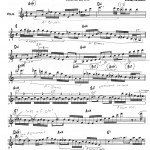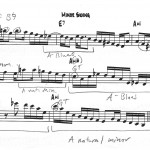This Thursday sokillingman.com broke 1,000 views, so thank you! We’re really excited to have so many people interested in this project and we have all sorts of plans for development. Here’s a little bonus post in celebration:
Download the PDF: Concert, Bass Clef, Bb, Eb
Minor Swing, music written by Django Rienhardt and performed by: The Quintette du Hot Club de France, featuring Django Rienhardt and Stéphane Grappelli. From Djangology, recorded in 1949 and released by RCA Bluebird.
This tune is absolutely classic, and very well could have been the first tune I heard that convinced me that I understood what Gypsy Jazz sounds like. It’s just that kind of recording. While it’s not the whole picture by any means, this tune exemplifies a lot of the rules and conventions of the genre and has a very balanced ratio of variety to continuity. So I figured this would be a great study tool for said reasons, and I love the solo, so it was a no-brainer.
One thing that sets this apart from the other Grappelli solo I transcribed (After You’ve Gone) is the featured rhythmic motives:
 In Minor Swing the very first beat is an iteration of this rhythm, which is repeated in a similar melodic figure the first beat of m. 5 (m. 5.1). It is notable that both of these examples kick off 4-bar phrases. From there on it can be found throughout the solo such as mm. 6.2, 11.3, 13.1, 14.1, etc. It can also be found in more subtle iterations such as beats 3+4 of m. 3. Arguably. It’s almost like an augmentation of the rhythm, but instead of just doubling the note values, the articulations are doubled as well. Kind of a stretch, but it shows up multiple times in the solo. Probably not consciously intentional, but more than likely there was an intuitive connection.
In Minor Swing the very first beat is an iteration of this rhythm, which is repeated in a similar melodic figure the first beat of m. 5 (m. 5.1). It is notable that both of these examples kick off 4-bar phrases. From there on it can be found throughout the solo such as mm. 6.2, 11.3, 13.1, 14.1, etc. It can also be found in more subtle iterations such as beats 3+4 of m. 3. Arguably. It’s almost like an augmentation of the rhythm, but instead of just doubling the note values, the articulations are doubled as well. Kind of a stretch, but it shows up multiple times in the solo. Probably not consciously intentional, but more than likely there was an intuitive connection.
 The ‘featured rhythm’ in Grappelli’s solo on After You’ve Gone is first introduced in m. 1.3, is 2 beats long, and also shows up in mm. 4.3, 16.4, 18.3, 24.3, etc. Most of the time it shows up at the ends of phrases, most importantly just before the guitar solo (m. 24.3), the very last lick of the tune, and Django ends his 4-bar solo with it (m. 28.3). My favorite treatment of this rhythm is where Grappelli ties it over the barline between mm. 16 and 17. This effectively connects two 4-bar phrases and extends the tension of the line. So cool.
The ‘featured rhythm’ in Grappelli’s solo on After You’ve Gone is first introduced in m. 1.3, is 2 beats long, and also shows up in mm. 4.3, 16.4, 18.3, 24.3, etc. Most of the time it shows up at the ends of phrases, most importantly just before the guitar solo (m. 24.3), the very last lick of the tune, and Django ends his 4-bar solo with it (m. 28.3). My favorite treatment of this rhythm is where Grappelli ties it over the barline between mm. 16 and 17. This effectively connects two 4-bar phrases and extends the tension of the line. So cool.
GT = Guide Tone
I mark guide tones only when they are played on big beats, one and three. GT are often used as foundation, or jumping off points for the soloist to go into more uncharted territory
Modes
I will sometimes mark the scale mode the soloist is using if I like how it is used.
ANT = Anticipation
When the soloist plays notes outside of a chord in anticipation of the next chord.
CAT = Chromatic Approach Tone
An example of a Chromatic Approach Tone is when the soloist surrounds the resolution note with half steps. For instance, if the soloist plays Ab-F# over a G7 and resolves to G over the CMA7, that is CAT.
This is similar to a Chromatic Approach tone, but diatonic. I usually only mark Double Neighbors, but sometimes the single ones are interesting. This is the soloists’ way of zeroing in on a note and building up the listener’s anticipation of the target pitch.
Alterations
I will sometimes circle alterations if they are prevalent, cool or reoccurring.

